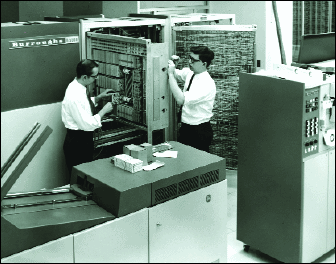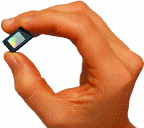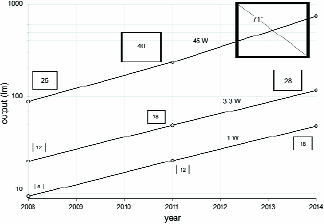The Future of Pico Projectors
Coming advances in projector throughput and LED brightness create a rapidly broadening design space for pico projectors that will lead to applications yet unforeseen.
by Mark A. Handschy and Bruce F. Spenner
COMPUTERS OF THE 1960s (Fig. 1) were large, slow, and power hungry. However, the introduction of the integrated circuit (IC) changed all that. Displays, though, have not seen similar progress: Today's low-power displays have small, low-resolution images, such as cell-phone displays, while high-information-content displays such as LCD TVs are large and power hungry. But, as we are just beginning to see, the combination of new high-brightness LEDs with IC-based micro-display imagers (Fig. 2) in pico projectors may launch displays on a trajectory matching that followed by IC-based computers.
Although others have characterized pico projectors as "low-lumen" devices, we assert they will soon be able to generate large (> 60 in.), bright images from an engine no larger than a standard incandescent light bulb. In the 60s, no one would have guessed that everyone would have a personal computer or that automobiles would be operated by hundreds of computers – 10 years from now imagine what small, bright, inexpensive pico projectors will bring.
Critical Pico-Projector Performance Parameters
Initial applications of pico projectors will likely be driven by small form-factor mobile electronics products such as PDAs and cell phones (Fig. 3). By decoupling image size from device size, pico projectors enable large, crisp images to be projected and shared with nearby friends and colleagues.
Market analysts divide mobile electronics pico-projector applications into three segments: palm (projector powered by wall plug), companion (projector powered by its own battery), and embedded (projector powered by platform battery).
The embedded segment with its large potential market draws the most attention because pico projectors that could be embedded into mobile-phone handsets would have an available market of 1 billion units annually. Achieving even small penetration into this market will require a pico projector with unusually high performance for its cost. In addition to producing enough light from an engine whose cost is a small fraction of the total handset cost, a successful pico projector will also have to be very small and consume very little power.

Fig. 1: Burroughs B5500 computer ca. 1964 (image courtesy of the Charles Babbage Institute, University of Minnesota, Minneapolis).
We believe single-panel color-sequential engines are the only feasible route to pico projectors that satisfy these requirements. The apparent simplicity of scanned laser projectors is appealing, but reducing their image speckle to acceptable levels may be more challenging than first thought. Projection engines based on three-panel color-splitting architectures offer high optical efficiency, but their cost, size, and complexity weigh against their use in pico projectors. Light absorption by their color filters reduces the optical efficiency of color-filter-array (CFA) micro-displays compared to field-sequential-color (FSC) displays. The large 2.5x efficiency difference detailed in Table 1 will result in power consumption in CFA pico projectors that is too high for embedded applications.
The optical throughput advantages of the FSC architecture can be retained, though, only if the standard-to-sequential video conversion can be accomplished without consuming significant power. Figure 4 compares a hypothetical color-sequential system with the usual external ASIC and frame buffer memory to a system like Displaytech's FLCOS imager where the sequential conversion is performed by the microdisplay backplane. Color-rate multipliers and digital gray-scale schemes mean high data bandwidths between the ASIC, the frame buffer memory, and the imager. In turn, high-bandwidth interconnect always consumes power. For a VGA system, we estimate the external electronics system plus imager consumes 600 mW, while less than 100 mW is consumed by the imager with internal conversion. This difference is very significant given the 1-W power budget expected for an embedded pico projector. The extra 0.5 W consumed by external drive electronics is power that cannot be delivered to the LEDs, reducing light output in a way that cannot be overcome even with a MEMS-based microdisplay (i.e., Texas Instruments DLP) using unpolarized light. The high-I/O-count ICs used in the external-electronics system also substantially increase the pico projector's size and assembly cost.
Pico-Projector Design-Space Evolution
Sequential-color pico projectors based on current technology could achieve light outputs varying from 8 lm for a 1-W engine to nearly 90 lm for a 45-W engine, creating a large design space for meeting different application needs. Advances in solid-state light sources, microdisplay imager performance, and projection-engine optics will greatly broaden this space over the next few years.
Light-source lumens are the first major element of pico-projector performance. Current LED products (Table 2) with emitting areas small enough that all their light can be used by a 0.5-in.-diagonal imager provide color-sequential illumination from 60 to over 800 lm, depending on LED die size and drive level.1 Today, effi-cacies range from 56 lm/W for the lowest light output to 19 lm/W at the higher drive level needed for the highest light output. Achievable LED output can be expected to increase in the future according to the well-known Haitz's law,2,3 which predicts LED light output per package to double every 18–24 months. To cast a similar law in a form relevant to pico projectors, we base our following predictions on the assumption that LED efficacy (lm/W) increases by a factor of 1.5x every 3 years at constant drive current density (A/mm2).

Fig. 2: Displaytech's 800 x 600 SVGA FLCOS microdisplay. Its on-board 2.6-MB memory for double-buffering digital video exceeds the memory capacity of the entire computer shown in Fig. 1.

Fig. 3: Mobile electronics are now capable of showing the same TV and movie content as large screens, but display sizes preclude the usual shared viewing experience (image courtesy of Apple).
Table 1. Comparison of CFA and FSC microdisplay optical efficiencies.
| |
CFA
|
FSC
|
Units
|
| LED efficacy (white) |
67
|
41
|
lm/W
|
| Pixel fill factor |
0.70
|
0.92
|
|
| Filter photopic throughput |
0.325
|
1.000
|
|
| Relative efficiency |
15
|
38
|
lm/W
|
Microdisplay optical throughput forms the second major element of pico-projector performance. The second column of Table 3 breaks down the 62% optical throughput typical of Displaytech's current SVGA imager; the next two columns enumerate improvement coming over the next 6 years. Broad-band anti-reflection (BBAR) coating of the imager window and increased FLC switching angle, along with incremental improvement in pixel fill factor, should increase the throughput to 74% within about 3 years. The next step, replacing the aluminum pixel mirrors by higher-reflectivity materials, along with continued incremental improvements, takes imager throughput to 86% (+6 years).
Projection-engine optical throughput forms the final element determining pico-projector light output. Table 4 breaks down engine throughput factors, with an exemplary engine today putting 15% of the light emitted by the LEDs onto the screen. Changing from a MacNeille-type polarizing beamsplitter (PBS) to one with higher round-trip throughput [such as 3M's Mulitilayer Optical Film (MOF)] and capturing the imager improvements of Table 3 are the principal improvements we speculate will occur in the next 3 years to push projector throughput to 24%. The use of future polarized light sources, such as lasers or polarized LEDs,4 eliminates the need for a polarization conversion system (PCS) and, along with continuing imager and illumination-optics improvements in the 6-year time frame, finally drives engine throughput to 38%.

| |
FLCOS
|
MEMS
|
UNITS
|
| Total system power |
1.0
|
1.0
|
W
|
| Electronics power |
0.1
|
0.6
|
W
|
| LED power |
0.9
|
0.4
|
W
|
| LED white efficacy |
56
|
56
|
lm/W
|
| Illuminator flux |
50
|
22
|
lm
|
|
Polarization throughput factors
|
| Pre-polarizer |
0.40
|
–
|
|
| PBS round trip |
0.85
|
–
|
|
| PCS |
1.60
|
–
|
|
| Total polarization throughput |
0.54
|
1.0
|
|
| Flux after polarization losses |
27
|
22
|
lm
|
| Throughput net of polarization |
0.30
|
0.30
|
|
| Projector output |
8.2
|
6.6
|
lm
|
| Overall efficacy |
8.2
|
6.6
|
lm/W
|
Fig. 4: System complement and light-efficiency comparison of sequential-color microdisplays with integrated (FLCOS) and external (MEMS) electronics.
Table 2. Current LED product performance.
| Maker |
Lumileds
|
Luminus |
| Type |
Rebel
|
PT54
|
| Drive (A) |
0.35
|
0.70
|
13.50
|
| Die size ( mm2) |
1.0
|
1.0
|
5.4
|
| CW green (lm) |
79
|
130
|
1400
|
| CW red (lm) |
61
|
100
|
700
|
| CW blue (lm) |
23
|
38
|
275
|
| G/R/B duty |
49/27/24
|
49/27/24
|
39/33/28
|
| FSC white (lm) |
60.5
|
100
|
854
|
| FSC power (W) |
1.1
|
2.4
|
45
|
| White efficacy (lm/W) |
56
|
41
|
19
|
Table 3. FLCOS imager optical throughput evolution.
| |
NOW
|
+3 Years
|
+6 Years
|
| Mirror reflectivity |
0.86
|
0.86
|
0.95
|
| Fill factor |
0.92
|
0.94
|
0.97
|
| Gap effects |
0.97
|
0.98
|
0.99
|
| FLC tilt |
0.90
|
0.97
|
0.97
|
| Air/glass reflection |
0.92
|
0.98
|
0.98
|
| ITO reflection |
0.98
|
0.98
|
0.99
|
| TOTAL |
0.62
|
0.74
|
0.86
|
| Pixel pitch (μm) |
11.75
|
11.75
|
11.75
|
| Interpixel gap (μm) |
0.50
|
0.35
|
0.20
|
| FLC switch angle (°) |
36
|
40
|
40
|
The performance parameters outlined in the above tables draw the boundaries of the pico-projector design space; within the space, different pico-projector configurations can support varying product requirements. For example, Table 5 shows how the light output achievable with the 1-W power allowance typical of an embedded application grows from today's 8.4 lm to 20 lm and then 48 lm. Figure 5 similarly shows the consequences of expected improvements for 3.3- and 45-W projectors, relevant to the companion and wall-plug segments, respectively (the 45-W projector is assumed to have a somewhat lower optical throughput than the others since its LEDs are too large for PCS).
Finally, Fig. 6 extrapolates the evolution of a 20-lm projector. Increased LED efficacy allows reduced LED size and power; smaller LEDs in turn allow the imager to shrink, reducing system size and cost.
Conclusions
Pico projectors are positioned to provide consumers with an all-in-one mobile-electronics experience – movies downloaded to the phone can be played back to friends. However, as we hope the above analysis shows, pico projectors need not be confined to low-lumen applications. Their small size, low noise level, and long lamp life will encourage their use as data projectors in conference rooms as future years bring increased lumen outputs.
With light output eventually approaching 1000 lm, as predicted in Fig. 6, one could imagine a wireless television that simply screwed into a standard light socket, as depicted in Fig. 7. Given their high light efficiency, their integration of all needed driver electronics into the single microdisplay backplane chip, and a projection screen being their only need for a full-diagonal material component, pico projectors may become the least expensive way to display an image in the 8–40-in.-diagonal range.
The future improvement of pico-projector performance can be predicted fairly certainly. The consequences of the improvements, though, cannot be seen any more clearly today than the personal computer was seen in the 1960s as the successor to mainframe computers.
Table 4. Pico-projector optical throughput evolution.
| |
NOW
|
+3 Years
|
+6 Years
|
|
Polarization
|
| Pre-polarizer |
0.43
|
0.43
|
0.80
|
| PBS |
0.84
|
0.92
|
0.92
|
| PCS |
1.44
|
1.53
|
1.00
|
| Total polarization |
0.52
|
0.61
|
0.74
|
|
Reflection
|
| Illuminator optics |
0.80
|
0.85
|
0.90
|
| Color combination |
0.80
|
0.85
|
0.85
|
| FLCOS imager |
0.62
|
0.74
|
0.86
|
| Projection lens |
0.90
|
0.90
|
0.90
|
| Total reflection |
0.36
|
0.48
|
0.59
|
|
Other
|
| Imager overfill |
0.83
|
0.86
|
0.91
|
| Temporal "fill factor" |
0.96
|
0.96
|
0.97
|
| TOTAL |
0.15
|
0.24
|
0.38
|
Table 5. Light-output evolution for 1-W example pico projector.
| |
NOW
|
+3 Years
|
+6 Years
|
| LED efficacy (lm/W) |
56
|
84
|
126
|
| LED power (W) |
1
|
1
|
1
|
| LED output (lm) |
56
|
84
|
126
|
| Projector throughput |
0.15
|
0.24
|
0.38
|
| Output (lm) |
8.4
|
20
|
48
|

Fig. 5: Pico-projector light-output roadmap. The 1-W line starts with a 56-lm/W illuminator efficacy; the 3.3-W line begins at a 41-lm/W efficacy, while the 45-W line begins at 19 lm/W. In following years, illuminator efficacy improves by a factor of 1.5 every 3 years. Projector optical throughput advances one generation of Table 4 every 3 years. Rectangles show the corresponding achievable image diagonal in inches for a 150-cd/m2 image brightness.
References
1D. Darmon, J. R. McNeil, and M. A.Handschy, "LED-Illuminated Pico Projector Architectures," SID Symposium Digest 39, 1070-1073 (2008).
2A. Bergh, G. Craford, A. Duggal, and R. Haitz, "The promise and challenge of solid-state lighting," Physics Today 54, 42-47 (2001).
3M. R. Krames, O. B. Shchekin, R. Mueller-Mach, G. Mueller, L. Zhou, G. Harbers, and M. G. Craford," Status and Future of High-Power Light-Emitting Diodes for Solid-State Lighting," J. Disp. Technol. 3, 160-175 (2007).
4H. Masui, H. Yamada, K. Iso, J. S. Speck, S. Nakamura, and S. P. DenBaars, "Non-polar-oriented InGaN light-emitting diodes for liquid-crystal-display backlighting," J. Soc. Info. Display 16, 571-578 (2008). •

Fig. 6: Performance roadmap for 20-lm pico projector. Increasing LED brightness and projector throughput allows smaller, lower-power LEDs to suffice; reduced LED area in turn permits smaller imagers at constant projector f/#.

Fig. 7: Artist's conception of lamp-socket pico TV.
Mark A. Handschy is Chief Scientist at Displaytech, 2602 Clover Basin Dr., Longmont, CO 80503-7604; telephone 303/772-2191 , e-mail: handschy@displaytech.com. Bruce F. Spencer is also with Displaytech.